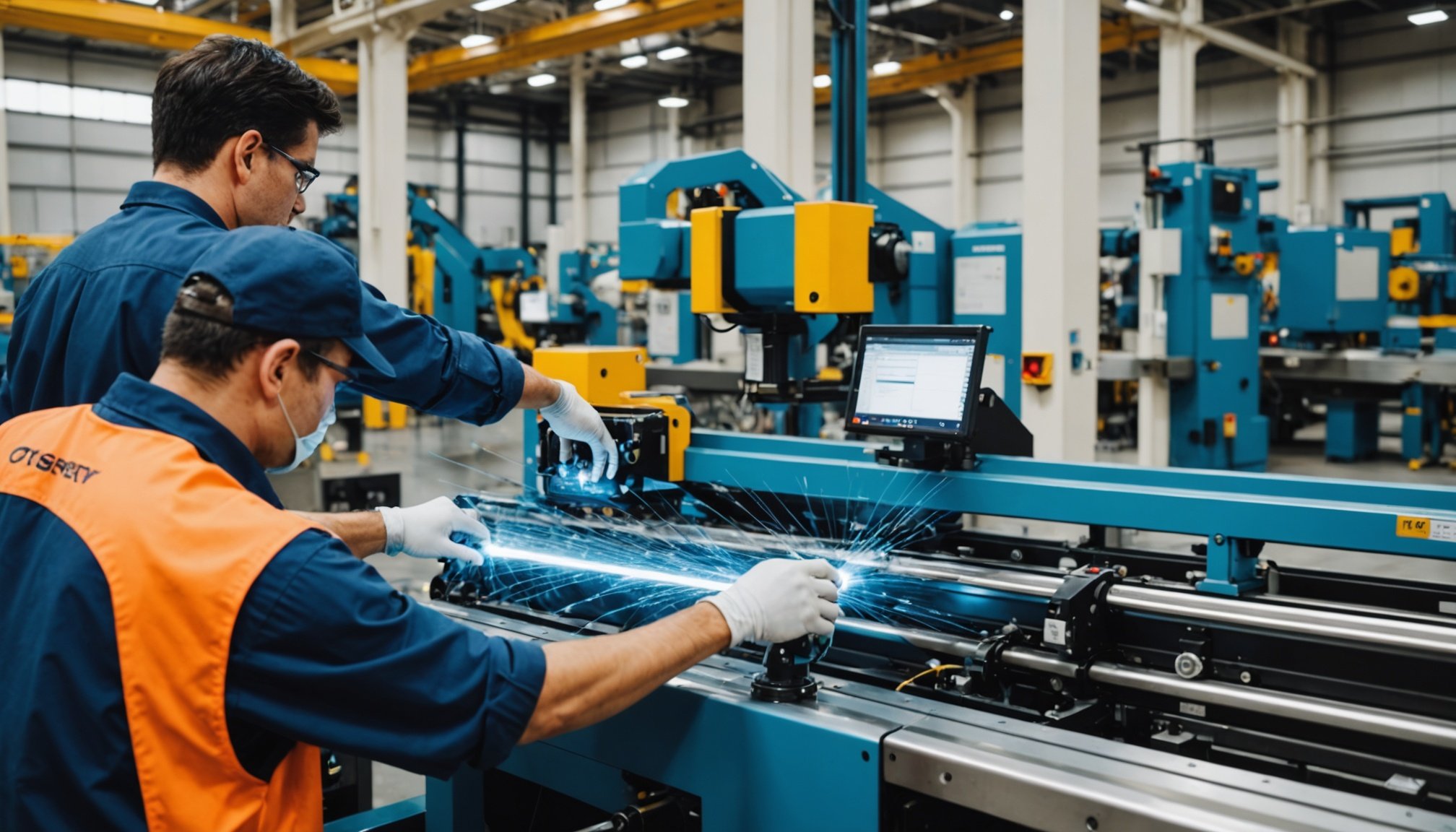Transforming Manufacturing Performance: Harnessing Digital Thread Technology for Enhanced Efficiency and Superior Product Traceability
In the ever-evolving landscape of the manufacturing industry, the concept of the digital thread has emerged as a game-changer, promising to revolutionize how products are designed, produced, and serviced. This article delves into the world of digital thread technology, exploring its benefits, implementation, and the transformative impact it can have on manufacturing performance.
What is the Digital Thread?
The digital thread is more than just a technical term; it represents a holistic approach to integrating data across the entire lifecycle of a product. It is essentially a digital chain that connects every stage of a product’s journey, from its initial design to its production, sale, use, and eventual disposal.
Also to read : Transforming stock trading: the impact of ai algorithms on instant decision-making
Breaking Down Silos
Historically, departments such as research and development (R&D), manufacturing, and service have operated in silos, hindering data flow and collaboration. The digital thread bridges these divides by creating a seamless flow of data, enabling businesses to unlock unprecedented collaboration between divisions, optimize operations, and bring products to market faster with less overhead[1][2][5].
Benefits of the Digital Thread
The adoption of a digital thread strategy offers a myriad of benefits that can significantly enhance manufacturing performance.
Also to read : Evernex: innovative it solutions for cost savings and sustainability
Increased Efficiency
By integrating data across departments, the digital thread streamlines processes, reduces downtime, and cuts costs. For instance, advanced analytics tools can help identify trends, predict issues, and optimize performance in real-time, leading to enhanced operational efficiency[2][3].
Enhanced Customer Experience
The digital thread enables personalized, proactive service by providing real-time data from products. This allows manufacturers to predict and prevent equipment failures, offer tailored maintenance schedules, and deliver a superior customer experience[2][4].
Greater Agility
With the digital thread, manufacturers can respond faster to market changes and stay ahead of the competition. By having a unified data management system, businesses can make informed decisions quickly, adapting to market demands with greater agility[2][3].
Key Pillars of the Digital Thread
Implementing a digital thread strategy involves several key pillars that are crucial for its success.
Unified Data Management
A single source of truth is essential for effective decision-making. Integrating data across departments ensures everyone has access to accurate, up-to-date information. This unified approach eliminates data silos and fosters better collaboration[2].
Real-Time Insights and Analytics
Data is only useful if it leads to action. Advanced analytics tools, often powered by AI and machine learning, help identify trends, predict issues, and optimize performance in real-time. This enables manufacturers to make data-driven decisions, enhancing operational efficiency and product quality[2][3].
Collaboration Across the Value Chain
The digital thread isn’t just about technology; it’s about people. When design, production, and service teams work together seamlessly, the results can be transformative. This collaboration ensures that the right information is available to the right people at the right time, facilitating better decision-making and innovation[2].
Seamless Integration of Technologies
The right digital thread strategy integrates with existing systems, ensuring a smooth transition. This involves leveraging cloud computing, edge computing, and other advanced technologies to create a cohesive digital environment that mirrors the real world[3].
The Role of Advanced Technologies
Several advanced technologies play a critical role in the implementation and success of the digital thread.
Artificial Intelligence (AI) and Machine Learning
AI enhances the capabilities of the digital thread by providing advanced tools for data analysis, predictive maintenance, and decision-making. For example, AI can be used for generative design of 3D printed parts and feature-based machining of complex components, freeing up valuable resources and personnel[1][3].
Digital Twins
Digital twins are virtual replicas of physical products or systems. They enable extensive analysis in the digital world before any real investment, optimizing processes and reducing costs. For instance, Siemens created a digital twin of its motors and drives factory, which helped in simulating various scenarios and optimizing the final facility’s operations[3].
Industrial Metaverse
The industrial metaverse represents an evolution in manufacturing, bringing together all digital technologies to transform the future of manufacturing. It leverages comprehensive digital twins, combined with information from edge devices and IoT sensors, to deliver a cohesive, physics-based digital environment. This immersive digital space helps companies anticipate potential issues and optimize operations before any physical production begins[3].
Practical Implementation and Case Studies
To understand the real-world impact of the digital thread, let’s look at some practical implementations and case studies.
Siemens’ Digital Transformation
Siemens’ experience with digital transformation is a compelling example. By creating a comprehensive digital twin of its factory in Nanjing, China, Siemens was able to optimize processes in the virtual environment before making any real investment. This approach reduced costs, ensured smooth operations from day one, and accelerated time-to-market[3].
Enhanced Aftermarket Success
Manufacturers can repurpose data from the digital thread to drive customer engagement throughout a product’s lifecycle. For instance, by tracing and reviewing sales data, manufacturers can better understand how individual components perform, how often they fail, and how regularly they need replacing. This creates a virtuous circle of data-driven innovation, informing future product designs and component supplier choices[4].
Table: Benefits and Key Features of the Digital Thread
| Benefit/Feature | Description |
|---|---|
| Increased Efficiency | Streamline processes, reduce downtime, and cut costs through integrated data management and real-time analytics[2][3]. |
| Enhanced Customer Experience | Deliver personalized, proactive service by predicting and preventing equipment failures and offering tailored maintenance schedules[2][4]. |
| Greater Agility | Respond faster to market changes and stay ahead of the competition with unified data management and real-time insights[2][3]. |
| Unified Data Management | Ensure everyone has access to accurate, up-to-date information by integrating data across departments[2]. |
| Real-Time Insights and Analytics | Use advanced analytics tools to identify trends, predict issues, and optimize performance in real-time[2][3]. |
| Collaboration Across the Value Chain | Facilitate seamless collaboration between design, production, and service teams to enhance decision-making and innovation[2]. |
| Seamless Integration of Technologies | Integrate with existing systems using cloud computing, edge computing, and other advanced technologies[3]. |
| AI and Machine Learning | Enhance data analysis, predictive maintenance, and decision-making capabilities using AI and machine learning[1][3]. |
| Digital Twins | Optimize processes and reduce costs by simulating scenarios in the digital world before real investment[3]. |
| Industrial Metaverse | Transform the future of manufacturing by leveraging comprehensive digital twins and real-time data from edge devices and IoT sensors[3]. |
Challenges and Solutions
While the digital thread offers numerous benefits, its implementation is not without challenges.
Data Silos
One of the significant obstacles is the presence of data silos. Research shows that nearly 60% of manufacturing executives cite data silos as a major hurdle to their digital transformation efforts. To overcome this, organizations must integrate their data across departments, ensuring a single source of truth[2].
Manual Processes
Manual processes can slow down operations and hinder the effectiveness of the digital thread. Automating these processes using AI and machine learning can help streamline operations and reduce errors[3].
Legacy Systems
Integrating new solutions with legacy systems can be challenging. However, the right digital thread strategy will ensure seamless integration, allowing businesses to transition smoothly without starting from scratch[2].: The Time to Act is Now
The digital thread is not just a buzzword; it is a strategic imperative for manufacturers looking to thrive in an increasingly competitive landscape. By breaking down silos and embracing connectivity, businesses can unlock new levels of efficiency, innovation, and customer satisfaction.
As Zvi Feuer, Senior Vice President of Digital Manufacturing Software Solutions for Siemens, notes, “By embracing a comprehensive digitalization strategy, manufacturers can digitally define entire workflows, enabling seamless collaboration between design, engineering, and manufacturing. This approach helps them achieve unprecedented levels of efficiency and productivity”[3].
Practical Insights and Actionable Advice
For manufacturers considering the adoption of digital thread technology, here are some practical insights and actionable advice:
- Start with a Clear Strategy: Define your goals and identify the key areas where the digital thread can add the most value.
- Integrate Data Across Departments: Ensure a single source of truth by integrating data across R&D, manufacturing, and service departments.
- Leverage Advanced Analytics: Use real-time insights and analytics to predict issues, optimize performance, and make informed decisions.
- Collaborate Across the Value Chain: Foster seamless collaboration between design, production, and service teams to enhance innovation and decision-making.
- Invest in Advanced Technologies: Utilize AI, machine learning, digital twins, and the industrial metaverse to transform your manufacturing processes.
- Address Legacy Systems: Ensure that your digital thread strategy integrates with existing systems to facilitate a smooth transition.
By harnessing the power of the digital thread, manufacturers can transform their operations, achieve greater efficiency, and deliver superior product quality. The future of manufacturing is digital, and the time to act is now.





